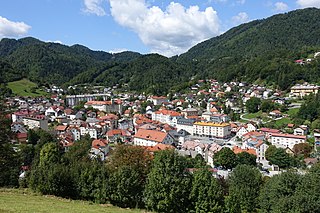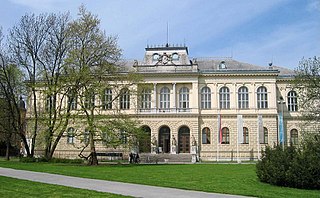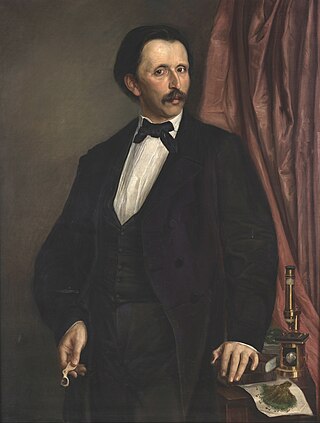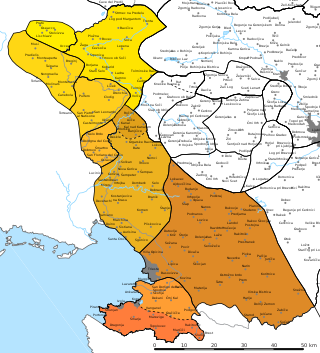
Idrija is a town in western Slovenia. It is the seat of the Municipality of Idrija. It is located in the traditional region of Inner Carniola and is in the Gorizia Statistical Region. It is notable for its mercury mine with stores and infrastructure, as well as miners' living quarters, and a miners' theatre. Together with the Spanish mine at Almadén, it has been a UNESCO World Heritage Site since 2012. In 2011, Idrija was given the Alpine Town of the Year award.

The Museum of Natural Sciences of Belgium is a museum dedicated to natural history, located in Brussels, Belgium. The museum is a part of the Royal Belgian Institute of Natural Sciences. Its most important pieces are 30 fossilised Iguanodon skeletons, which were discovered in 1878 in Bernissart, Belgium.

Sigmund Zois Freiherr von Edelstein, usually referred as Sigmund Zois was a Carniolan nobleman, natural scientist and patron of the arts. He is considered one of the most influential figures of the Enlightenment Era in the Slovene Lands of Habsburg Austria.

Anton Tomaž Linhart was a Carniolan playwright and historian, best known as the author of the first comedy and theatrical play in general in Slovene, Županova Micka. He is also considered the father of Slovene historiography, since he was the first historian to write a history of all Slovenes as a unit, rejecting the previous concept which focused on single historical provinces. He was the first one to define the Slovenes as a separate ethnic group and set the foundations of Slovene ethnography.
The Nevljica is a river in the Municipality of Kamnik, Slovenia. It has its source below Kozjak Hill and flows through the Tuhinj Valley. It also flows through the settlements of Nevlje and Mekinje. It is a left tributary of the Kamnik Bistrica.

Brdo Castle near Kranj, usually simply Brdo Castle, is an estate and a mansion in the Slovenian region of Upper Carniola west of the village of Predoslje, City Municipality of Kranj, northwest of Ljubljana. It is the Slovenian government's main venue for diplomatic meetings and other Government-sponsored events.

Upper Carniola is a traditional region of Slovenia, the northern mountainous part of the larger Carniola region. The centre of the region is Kranj, while other urban centers include Jesenice, Tržič, Škofja Loka, Kamnik, and Domžale. It has around 300,000 inhabitants or 14% of the population of Slovenia.

Valentin Vodnik was a Carniolan priest, journalist and poet of Slovene descent. He was active in the late Enlightenment period. He is well known for his contributions in writing materials that lifted the prestige of the Slovene language creating a standard meant to unify the people of Slovene Lands in a single intelligible tongue.

Belsazar de la Motte Hacquet was a Carniolan physician of French descent in the Enlightenment Era. He was a war surgeon, a surgeon in the mining town of Idrija, and a professor of anatomy and surgery in Laibach. He researched the geology and botany of Carniola, Istria, and nearby places, and was the first explorer of the Julian Alps. He also did ethnographical work among the South Slavic peoples, particularly among the Slovene-speaking population. He self-identified primarily as a chemist and introduced the methods of chemical analysis to Carniola.

The Kresija Building is a building that together with Philip Mansion marks the entrance to the old town of Ljubljana, the capital of Slovenia. It stands at the Adamič and Lunder Embankment on the right bank of the river Ljubljanica immediately after the Triple Bridge and borders Pogačar Square, Stritar Street, and Maček Street. Until 2007, the Ljubljana Center Administrative Unit was stationed in the building. Now, it houses a number of municipal offices, the Kresija Gallery, and the Ljubljana visitor centre.

Zois Mansion is a mansion in Ljubljana, the capital of Slovenia. It stands in the Center District, at Breg, a street on the west (left) bank of the Ljubljanica, between Teutonic Street to the north and Zois Street to the south. The mansion served as residence of Baron Sigmund Zois, a leading figure of Enlightenment in the Slovene Lands of the Austrian monarchy and supporter of the revival of Slovene culture and literature.

Congress Square is one of the central squares in Ljubljana, the capital of Slovenia.

The National Museum of Slovenia is located in Ljubljana, the capital of Slovenia. It is located in the Center district of the city near Tivoli City Park. Along with the Slovenian Museum of Natural History, located in the same building, the National Museum of Slovenia is the country's oldest scientific and cultural institution. The museum has an extensive collection of archaeological artefacts, old coins and banknotes and displays related to the applied arts. In 2021 it's been given the golden Order for Exceptional Merits by the president of Slovenia, Borut Pahor.

St. James's Parish Church is a church in Ljubljana, the capital of Slovenia. It is dedicated to St. James the Greater. Its name is often incorrectly translated as St. Jacob's because Slovene, like many other languages, uses the same word for both James and Jacob.

Cekin Mansion is a mansion on the northern edge of Tivoli Park in Ljubljana, the capital of Slovenia. It is located next to Tivoli Hall in the Šiška District. It houses the Museum of Contemporary History of Slovenia.

Nevlje is a settlement on the Nevljica River in the Municipality of Kamnik in the Upper Carniola region of Slovenia. It is located approximately 1 kilometre (0.62 mi) from Kamnik.

Karel Dežman, also known as Dragotin Dežman and Karl Deschmann, was a Carniolan liberal politician and natural scientist. He was one of the most prominent personalities of the political, cultural, and scientific developments in the 19th-century Duchy of Carniola. He is considered one of the fathers of modern archeology in what is today Slovenia. He also made important contributions in botany, zoology, mineralogy, geology and mineralogy. He was the first director of the Provincial Museum of Carniola, now the National Museum of Slovenia. Due to his switch from Slovene liberal nationalism to Austrian centralism and pro-German cultural stances, he became a symbol of national renegadism.

Scopolia carniolica, the European scopolia or henbane bell, is a poisonous plant belonging to the family Solanaceae. It has dark violet flowers on long hanging stems. It grows to 60 centimetres (24 in) in height. Its toxicity derives from its high levels of tropane alkaloids, particularly atropine. The concentration of atropine is highest in the roots.

This article uses Logar transcription.

Josef Kalasanz Freiherr von Erberg was a Carniolan botanist, cultural historian, collector, and patron of the arts.




















